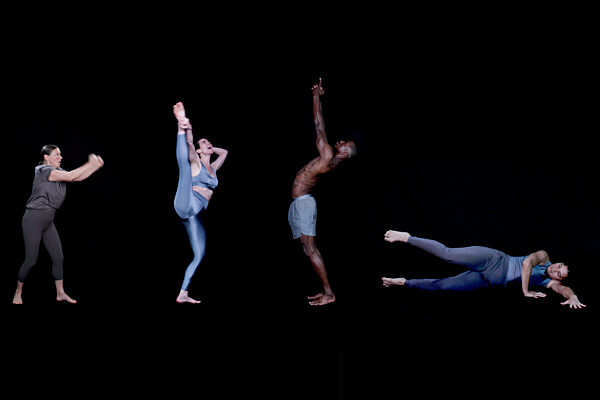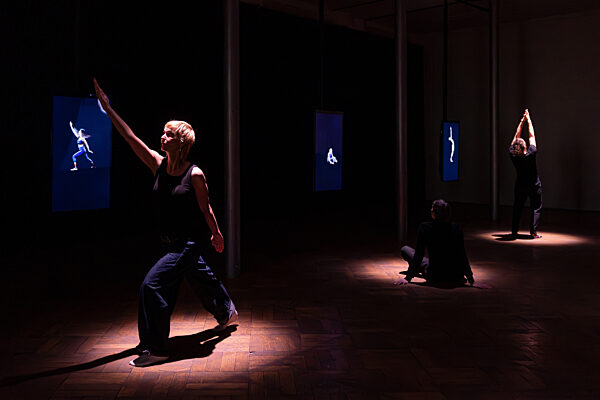
and& Art Expo - Look At Us Now
A selection of audiovisual installations that critically approach innovative tech & design
The exhibition is free, but due to the COVID measures we work with a mandatory reservation. Therefore, capacity is limited to 16 people per timeslot, and there is no waiting list. Book your timeslot of choice via the link below.
Innovation promises us a better life. But what qualifies as better? And for whom? The artists in the and& exhibition Look At Us Now offer new perspectives on innovation and on the way we perceive the challenges of our time. Nine audiovisual installations relate to themes such as artificial intelligence, water pollution, ideas of progress, sensory overload, and feminism.
Avoiding any explicit strategies, the artists included in the exhibition work in a way which intrigues, questions or perhaps even seduces: the artworks pull you in with a deafening silence, a beautiful sound, an intriguing dialogue or a fascinating visual language. They reveal more and more, the longer you share the space with them; watching, listening, thinking.
Look At Us Now takes stock of our current state of affairs. In light of the impact of technology and innovation on the way we live together, the exhibition presses the pause button, and invites you to take it all in, just for a moment, here and now.
Artists: Haroon Mirza, Mike Mills, Trevor Paglen, Angela Washko, Roel Heremans, Zimoun, Marco Barotti, Amanda Parer, Yann Leguay
Curated by: Gilles Helsen & Karen Verschooren
The exhibition Look at Us Now is part of and& 2021 and can be seen as a side note to the baseline 'Innovate for the better’.
With the support of: Flanders, Bank Degroof, imec, KU Leuven, City of Leuven, Deloitte, GIMV, Cresco, Cronos, SAS, Technopolis, Telenet, Leuven Mindgate, VOKA, Canvas, De Standaard, Radio 1, Trends
Special thanks to: Altman Siegel San Francisco, Greenery of the City of Leuven, KADOC, KU Leuven Dienst Cultuur, Kunstenwerkplaats Pianofabriek, Lisson Gallery, Metro Pictures New York, The Museum of Modern Art (MoMa), Overtoon, San Francisco Museum of Modern Art, Warm Alarm, Werktank, Workspacebrussels
Also in the Music & Arts programme of and&: Max Cooper's installation Transcendence in the Sint-Michielskerk, by our colleagues of Het Depot. More info via the link below.
Photo credits
Haroon Mirza - The National Apavilion of Then and Now © Haroon Mirza, Courtesy Lisson Gallery
Mike Mills - A Mind Forever Voyaging Through Strange Seas of Thought Alone: Silicon Valley
Trevor Paglen - Image Operations, Op. 10 (video still), 2018. Courtesy of the artist and Metro Pictures, New York
Angela Washko – The Game: The Game. Still from videogame. 2019
Roel Heremans - Quartet B © Nick Chesnaye
Zimoun - 168 prepared dc-motors, cotton balls, cardboard boxes © Zimoun Le Centquatre Paris
Yann Leguay - Volta
Marco Barotti - Clams
Amanda Parer - Fantastic Planet. Canary Wharf UK. Photo credit. Parer Studio
The National Apavilion of Then and Now
Haroon Mirza
The National Apavilion of Then and Now is an audiovisual pavilion by British media artist Haroon Mirza. On the inside, the structure is lined with triangular sound-insulating foam, making it work like an ‘anechoic chamber’ in which neither light nor sound is reflected. This total absence of reflection and the lack of external impulses creates an extreme focus that brings you completely to the here and now. As a result, the work embodies the expo baseline Look At Us Now: take a moment to reflect on yourself and the world. In the center hangs a white LED circle, almost as a symbol of spiritual perfection. After a period of total darkness, this circle becomes brighter and brighter, accompanied by an increasingly loud electronic sound. When the room fades completely into darkness, the cycle starts again.
Credits
2011
Anechoic chamber, LEDs, amp, speakers, electronic circuit
129 15/16 × 314 15/16 × 275 9/16" (330 × 800 × 700 cm)
Courtesy of The Museum of Modern Art (MoMa)
Gift of Lisson Gallery
A Mind Forever Voyaging Through Strange Seas of Thought Alone: Silicon Valley Project
Mike Mills
Voor A Mind Forever Voyaging Through Strange Seas of Thought Alone: Silicon Valley Project, artist and filmmaker Mike Mills interviewed a series of children, whose parents work in the tech-industry—from high-level product managers to a chef at Google. Mills discussed with them their depictions of the future. He adds: “There is this whole industry of adult futurists making these predictions, but what about the people who will actually be inhabiting the future, which is all these kids. To hear it [these visions] from a cheery, happy ten-year-old, is somehow particularly icy, and really spooky." The work is part of a triptych of work, which was commissioned by SFMOMA for its off-site exhibition, Project Los Altos (2013), inspired by the Northern Californian hub and birthplace of Apple computers.
Credits
2013
Video installation, 38’, loop, sound
Courtesy of the artist and SFMOMA Collection
Image Operations
Trevor Paglen
Image Operations by American artist Trevor Paglen is a video of four musicians performing Debussy’s String Quartet in G Minor, op. 10. As the performance proceeds, the perspective slowly changes from that of a camera, to that of an array of computer vision systems ‘interpreting’ what the camera is seeing. At first, we see the action through simple face detection software. Later, we watch the performers through algorithms used in self-driving cars, guided missiles, drones and powerful artificial intelligence algorithms that estimate age, gender, and the emotional states of the performers. Examining the ‘styles’ of seeing these different systems use, Paglen questions the power structure reflected in their training sets and acknowledges that the underlying assumptions are far from neutral.
Credits
2018
Single channel video installation, colour, Dolby surround sound 5.1, 23’ (loop)
Courtesy of the artist; Metro Pictures, New York; Altman Siegel, San Francisco
Quartet B: Still Life
Roel Heremans
Quartet B: Still Life is a new work by Belgian transdisciplinary artist Roel Heremans, commissioned by and&. In this participatory experience for four random participants, Heremans invites you on a mental journey through headphones. A voice leads you along thoughts and movements. The text raises questions about the sociological consequences of social media algorithms and briefly brings you back from digital to real life. At the center is a mirrored monolith: a reference to the many mysterious monoliths that have surfaced around the world in the past year and also an invitation to a contemporary ritual.
Credits
2021 - commission
Coproduction: STUK - House for Dance, Image & Sound, Kunstenwerkplaats Pianofabriek, workspacebrussels, Werktank, KU Leuven Dienst Cultuur, Overtoon
Special thanks to: Jeanna Criscitiello, Erki De Vries, Emanuele Dainotti, HISK, S.M.A.K., Recording Studio Chez Freddy
168 prepared dc-motors, cotton balls, cardboard boxes 70x70x70cm
Zimoun
For the Swiss sound artist Zimoun, the expression ‘nomen est omen’ applies: this monumental installation consists of 168 motors, cotton balls and an enormous wall of cardboard boxes measuring 70 square centimeters. The large number of balls hitting the cardboard creates a thick cloud of sound. An enormous haze in which each partial element can no longer be heard separately. Or can you? Zimoun himself always emphasizes the musical and sensory aspect of his art. But because of his radical choice of industrial (waste) materials and focus on oppositions such as chaos versus order and mass versus individual, you can also read his work in a social way: how do you deal with an endless stream of stimuli? And how can you still hear the individual voices in the mass?
Credits
2021 - commission
Studio Zimoun
Volta
Yann Leguay
Technology has never been so undemocratic: smartphones and cutting-edge technologies are in the hands of a limited group of large multinationals; mechanics or electricity are increasingly disappearing in favor of microchips and invisible interfaces. Yann Leguay questions this trend and explores the potential of purely electrical or mechanical sound. In his installation Volta, the Brussels-based sound artist creates an electric arc through a plasma speaker. A sound file is sent through this high voltage and a voice is created. This voice tells about the magical nature of technology, floating between present and future, between identification and materiality.
Credits
2019
Electrical support: Guillaume Bernier / Text: ∏node / Voice: Jean-François Blanque / Video: Jerome Fino / Stochastique / Place: La Compilothèque
Production: Overtoon, supported by Flanders State of the Art
Special thanks to KADOC
Clams
Marco Barotti
In nature, clams are detectors of water pollution. They also serve as small filter systems. Inspired by this natural phenomenon, Italian media artist Marco Barotti created his work Clams, a sound installation that is triggered by water quality. The artist measures the pollution of the water in the ‘Vaartkom ‘ (a canal basin) of Leuven. That data is converted into audio signals in real time. This creates a soundscape that generates the opening and closing of the 64 shells. So you can actually see and hear water pollution. The shells themselves are handmade one by one by the artist from recycled industrial plastic waste.
Credits
2019
Created & produced by Marco Barotti.
Developed at WRO Art Center within the framework of EMAP / EMARE.
Co-funded by Creative Europe, C-Takt, Oerol Festival & Transnatural.
Supported by Dayton Audio - “In-Situ” water quality measurements.
Many thanks to: Anna Anderegg for conceptual advises & Pim Boreel for Hydro4Live development.
The Clams are awarded from the NTU Global Digital Art Award Singapore.
This projects takes part of ‘Warm Alarm’: sogetinformed.com
Fantastic Planet #5: What’s That?
Amanda Parer
“I raise questions about our relationship with the natural world, communicating this through the use of scale, drama, light, and humour. I aim to entice my audience with beautiful, mostly invasive (including us) or endangered species, standing prominent and dominant in their given habitats.” - Amanda Parer
Fantastic Planet is an artwork comprising a series of giant illuminated humanoid figures which seemingly have just landed and are quietly and gently exploring our ‘fantastic planet’. The work is inspired by the 1973 Czech / French film La Planète Sauvage, directed by René Laloux, which depicts a story set in an unimaginably distant future in a world populated by gargantuan humanoids and where human beings are a feral race. This view is shared by naturalist David Attenborough, when he stated that contemporary humans are threatening their own existence and that of other species by using up the world’s resources. “We are a plague on the Earth. It’s not just climate change; it’s sheer space, places to grow food for this enormous horde. Either we limit our growth, or the natural world will do it for us,” he told the BBC Radio Times in 2017.
In the context of the exhibition Look At Us Now, one of the figures of Fantastic Planet has just landed, here in the city park of Leuven. The gigantic humanoid figure can be read in multiple ways: it becomes an emblem for our position on earth; larger than life. But beyond that, its posture signals something else yet: Is he trying to stand up, trying to move forward, perhaps after downfall? Or on the contrary, is he performing the opposite gesture; kneeling down, bowing to earth? Perhaps a gesture of humility?
Locatie
Bijkomende info
Opening hours
Tu 20.4 18:00 - 22:00
We 21.4 10:00 - 22:00
Th 22.4 10:00 - 22:00
Fr 23.4 10:00 - 22:00
Sa 24.4 10:00 - 22:00
Su 25.4 10:00 - 18:00










